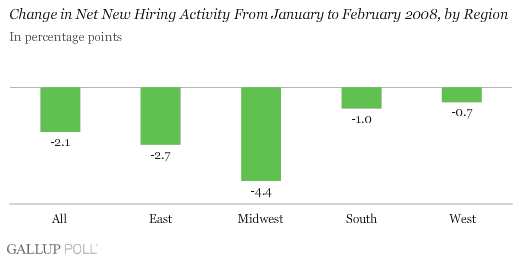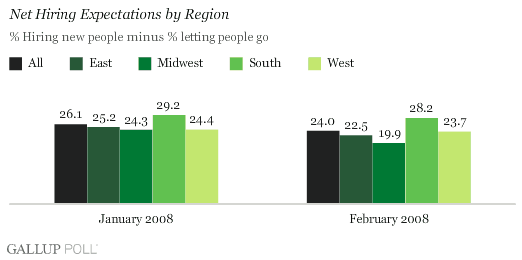PRINCETON, NJ -- An analysis of daily Gallup polling shows a drop of 2.1 percentage points in net new hiring activity in the U.S. economy from January to February 2008.

Survey Data Suggest Weak Job Growth
On Wednesday, an employment report from ADP Employer Services showed that private companies in the United States reduced their payrolls in February. While the ADP employer survey has not always been an accurate predictor of future job growth, Gallup's new jobs data lead to a similar conclusion: job growth probably declined at least slightly in February.
Gallup's net new hiring activity measure fell 2.1 percentage points in February. The measure is based on employees' perceptions of hiring and firing activity at their places of employment. It shows that employees were slightly more likely to see their employers reducing their net hiring activity in February than was the case in January. The biggest drops were in the Midwest, where perceptions of employment activity fell 4.4 points, and in the East, where net new hiring fell 2.7 points. Smaller net new hiring declines took place in the South (-1.0 points) and the West (-0.7 points).

New Hiring Activity Declines and Layoffs Increase
Gallup has been tracking net new hiring activity on a daily basis since the beginning of January 2008. In order to calculate this measure, Gallup asks employees whether their employers are hiring new people and expanding the size of their workforces, not changing the size of their workforces, or letting people go and reducing the size of their workforces. Net new hiring activity is computed by subtracting the percentage of employers letting people go from the percentage hiring new employees.
The percentage of employees saying their employers are hiring new people declined slightly from 39.8% in January to 38.5% in February. These calculations are based on more than 15,000 interviews conducted in January and more than 8,000 interviews conducted in February. This Gallup measure is new, and shows a net positive reading even in the current negative economic climate and even as overall U.S. employment declines. Companies are continuously hiring, and employees often find it difficult to differentiate hiring for new jobs from hiring to replace employee turnover.
At the same time, the percentage of employees saying their employers are letting people go increased from 13.7% in January to 14.5% in February. Again, this reading could be influenced by downsizing within some part of a company while the company overall is actually increasing the size of its workforce.
Of course, the importance of measuring these two areas despite some of their limitations involves trending and regional comparisons. By subtracting the percentage of employers letting people go from the percentage hiring, a measure of net new hiring activity is derived that can be analyzed and monitored over time. As a result, less emphasis is placed on the overall absolute levels of "hiring" or "letting people go," or the net of these two measures, and more emphasis is given to the change in net new hiring activity over time and across regions over time. Therefore, while net new hiring activity equaled 26.1% in January and 24.0% in February, the important finding involves the drop of 2.1 points in this overall activity level.
Is the U.S. Economy Creating New Jobs?
On Friday morning, the Bureau of Labor Statistics (BLS) will issue a new jobs report. Of course, there has been a lot of bad economic news recently with all of the factors buffeting the U.S. economy, including surging oil and food prices, the credit crunch, the decline in the value of the U.S. dollar, falling housing prices, and signs consumers are pulling back on their non-essential purchases. Given such an economic backdrop, Friday's report takes on added significance because it could confirm or deny the recessionary nature of the current economic downturn, not to mention the need for the Fed to continue driving down interest rates.
As noted, Gallup's net new hiring activity estimates are based on large sample sizes involving more than 15,000 employees in January and more than 8,000 in February. The government's unemployment rate and the new job growth numbers reported by the BLS tend to be volatile and subject to substantial revisions over time. Given those facts, however, Gallup's daily monitoring of the U.S. jobs situation suggests that the unemployment rate has a reasonable probability of ticking up slightly in February while the number of new jobs created may have declined somewhat. Of course, given the brief history of Gallup's daily tracking of the employment outlook, its relationship to the government figures and other economic indicators is still being determined. Over time, the accuracy of Gallup's tracking data for predictive purposes should improve.
Survey Methods
Gallup is interviewing no fewer than 1,000 U.S. adults nationwide each day during 2008. The economic questions analyzed in this report are asked of a random half-sample of respondents each day. The results reported here are based on combined data of more than 15,000 interviews conducted in January and more than 8,000 interviews in February. For results based on these samples, the maximum margin of sampling error is ±1 percentage point. In addition to sampling error, question wording and practical difficulties in conducting surveys can introduce error or bias into the findings of public opinion polls.
